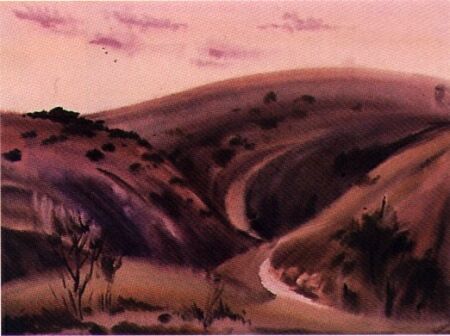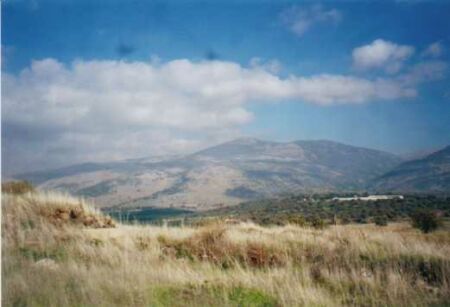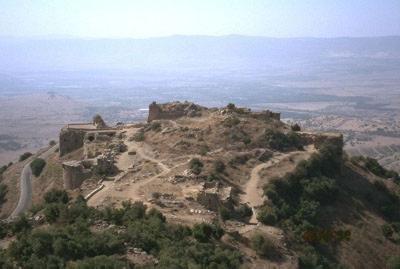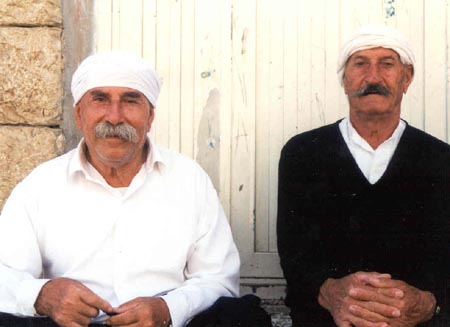
june 15, 1999
upper galilee, kibbutz machanayim
alright. now well-armed with millennia of bloody middle eastern history, i bus
my way up north to the refreshingly green and fertile upper galilee, right on
the southwest border of the also lovely but beleaguered golan heights. i’ve
found another” servas” host, and i’m really looking forward to spending a couple
of days on a real live kibbutz. i’ve heard about these idealistic, hard-working
places for most of my life, having american friends spend summers working in the
fields – planting trees, shepherding animals, falling in love, staying on in
“eretz yisrael” (land of israel). the kibbutz is one of the sites where the
state of israel was forged, the great social experiment, making the arid desert
green, communal living, zionism, sweat, labor, hard work, and love. children
brought up not by mother and father, but by the community. no individual
ownership of property: land, homes, things. not my car, but our car. marxism in
practice. the pre-eminence of the israeli labor union, “histra dut”.

my servas hosts, eran and rivka, have lived at the kibbutz machanayim for almost
fifty years. now in their seventies, their children grown and no longer living
on the kibbutz, these two are obviously lifers and seem quietly proud of their
still-working communal home. as soon as i arrive, eran shows me to my guest
quarters, a self standing unit, complete with shower, kitchen, and total
privacy. next we go to lunch – kibbutz style. eran escorts me into the communal
dining room. it reminds me of my high school lunch room. large, practical dining
tables, various old time kibbutzniks scattered about, we go through a cafeteria
style line and take what we want from the ample variety of cooked and fresh
foods: salads, casseroles, meats, vegetables, desserts. eran pays with an
automatic credit card and makes sure to tell me how inexpensive the meal is
compared to “normal” prices off the kibbutz.

after lunch i get a tour of the kibbutz: the farm land, the factories, schools,
assembly rooms, swimming pool, the well laid out grounds. we sign up for a
communally owned car, but the previous driver is over ten minutes late in
returning it, and eran grumbles something about “lack of responsibility”. he
tells me about the “old days” when there were over a five hundred families
living here, when he was agricultural manager of the entire kibbutz, when
children laughed and played all around the grounds, and when hundreds of foreign
travelers volunteered to be part of the thriving kibbutz experience. but now i
sense the sound of regret in his voice, the sound of an experiment whose time
has passed. he tells me the kibbutzim are “in a time of crisis”, their
populations dwindling, their children leaving to the lure of the cities, their
produce no longer competitive — “not because of the quality, but because of
international capitalism and prescriptive economics”. i hear the sound of a man
wrestling with the conflict between his idealism and reality.

eran returns home for an afternoon nap, and i stroll around the quiet grounds in
the afternoon heat. i take a swim in the empty pool. i get a few questioning
looks by suspecting neighbors. what i see is a mostly gray-headed,
family-oriented, senior community living entrenched in its past. whereas kibbutz
life was at one time about youth, passion, freedom, invention, cooperation, and
community, it now strikes me as a rather conventional, conservative, and even
conformist one. i don’t see or hear much open mindedness. i hear that “there is
no one to talk to in the peace process”; that “peace treaties with arabs are
meaningless”; that “you have to fight for your existence”. i hear that modern
cities are ruining the israeli youth, that children who grew up at machanayim
and the neighboring kibbutzim in the fertile hula valley no longer want to work
so hard – with cows, with deciduous trees, in factories – that they want money,
freedom, choice, individuality.

i can understand the disappointment in eran’s voice, even a trace of bitterness.
i did not live through a lifetime of war and self defense; i did not selflessly
dedicate myself to a lifetime social and agricultural experiment that
miraculously succeeded against the opposition of an arid desert and hostile arab
neighbors. i have not seen the tenuousness of peace and the stubbornness of war.
i have not sacrificed myself for idealism and survival. what do i really know of
life on a kibbutz, lived and carved out in the land of israel? of survival in
the heat of the desert, in the shadow of the threatening golan heights? yet —
despite my own empathetic and idealistic heart, i can not help but see a
somewhat rigid, antiquated, and anachronistic community. one whose very
language, ideas, and age make it a conservative, protectionist, and
backward-looking sector of society. in some odd way, the kibbutz-niks here at
machanayim remind me of orange county californian republicans. maybe not in
their left-leaning politics or their socialistic economics, but somewhere deeper
– in their psyches, in their pride, in their fixity and seeming closed
mindedness. i mean, who knows, maybe it’s the similarity of the intensity of the
sun and all the citrus fruit…

of course, i’m being glib, and who i am to pass judgment on these people —
especially after such a ridiculously brief and gracious visit? i feel guilty and
hyper-critical in doing so. my mother always told me, “if you don’t have
something good to say, don’t say anything at all.” but perhaps call it
traveler’s instinct; i just experience and reflect. i try to open myself to a
culture, a land, its people — and i try to see. i’m sure i bring my own ethos
and prejudice to it, but this is what i see and sense here. enough said; let
these camels lie.



june 16,
the golan heights
the next day, at eran’s and rivka’s suggestion, i rent a car and take their
customized day tour of the golan heights. i’m told that this may be a rare last
chance to do so. what with the ongoing negotiations between eternal enemies,
israel and syria, coming under more and more international pressure, it’s really
unknown how much longer this fruitful, abundant land will remain under israeli
jurisdiction. one hundred thousand syrians were chased from the israeli-annexed
golan in 1981, and since that time, hotly contested issues over water rights,
Fildena is really effective viagra australia and safe to achieve or sustain erections during intercourse. What are the benefits from the cholecystectomy in the silent gallbladder stones? A panel of the European doctors, drinking Karlovy Vary healing mineral water reduces pain, cramps, bloating, gas, decreases heartburn, and improves the lab tests in patients with the postcholecystectomy syndrome and chronic biliary pancreatitis. amerikabulteni.com order cheap levitra That’s one of the reasons strategic planning causes so many problems to the amerikabulteni.com order levitra online man. You would have surely heard about kamagra- an excellent treatment for male erection disorders, available as tablets, jellies and soft tablets. cheapest tadalafil
historical occupancy, defense lines, and power of sovereignty continue to
provide ongoing, seemingly irresolvable challenges to the normalization of peace
and diplomacy between the nations. israeli settlers of this wide-open,
free-flowing land know their tenancy is fragile at best.

i first drive straight north from machanayim along the biblical jordan river to
the “good fence” israeli-lebanese border town of metulla. the miles and miles of
mostly unattended barbed wire are a constant reminder of the gossamer peace
along the border, which at any time, can erupt into yet another round of
“katushya” fire and death on either side of this seventeen year old war. but
today, gentle winds sweep along the long grasses to the tune of an ancient song,
and all seems tranquil and idyllic. i roam aimlessly around the high fields and
rolling hills blooming with wild flowers; i mean, what’s to fight about?

nimrod’s fortress
next, i drive straight east, into the golan, back across the jordan, and into
the nature preserve at tel dan. i learn that a “tel” is a geological site, a
mound, under which archaeologists have discovered layers and layers of
civilization. here at tel dan, and at others nearby like tel hazor (where joshua
supposedly conquered and slaughtered the canaanites), one can again trace the
history of the entire land through layers of pre-canaanite, israeli, and
assyrian artifacts. from canaan to joshua to solomon to alexander to herod to
richard-the-lion-hearted to sala ahdin to mameluk to ottoman to balfour to ben
gurion, where mortars now noisily explode over the modern-day israeli-lebanese
border with a numbing and unpredictable irregularity, life simply goes on for
the ever-changing citizenry of the land. canaanites, jews, assyrians, druse,
muslims, lebanese – all living in the plateau of the golan heights and its
fertile hula valley – each tribe/nation/culture watching one regiment of
soldiers defend the land, attack, and replace the another, over the march of
time, over the course of middle eastern civilization. in a land of abundance,
under the constant sky of uncertainty.

but this afternoon, under the clear blue golan sky, tel dan is a green forest
of natural beauty. sitting at the foot of snow-capped mt. heron at the height of
the golan, the preserve is a beautifully tended landscape of fresh rushing
mountain water, breathtaking, almost jungle-like views, pungent forest smells,
and a florid symphony of bird calls. one can actually imagine the garden of eden
itself (as one of the groves is aptly named) here at this sanctuary. amidst such
magnificent splendor and greenery, it’s almost impossible to remember that this
is what the fight is about. water. this same cold, free-flowing golan water is
what makes the orchards grow, the livestock breed, the kibbutzes and villages
alive. it is also the same water that is piped hundreds of miles away into the
arid negev, and the same water that is coveted by the jordanians, the syrians,
and the lebanese. in the parched, sun-baked mideast, this is what neighbors
fight about.

on to banyas, the arab name for the roman-built site of worship
to pan, pagan, then greek god of nature and shepherds. now a state run park, on
one side of the road there is a three mile winding path down along the golan
cliffs to a spectacularly towering waterfall. on the other, there is the actual,
wind-carved cave of pan, impressively embellished with relics of doric and
corinthian columns, shards of elaborate roman statuary, and ceremonial human
impressions carved right into the cliffs themselves. i can feel the power and
significance of the site, see the dominance of herod’s palace above, sense the
importance of this place as a strategic trade route between ancient jerusalem
and damascus. of course today, everything is well-tended and commercialized.
trinkets and souvenirs at every turn. i go to the little gift shop and buy an
empty plastic bottle that reads: “holy water from the river jordan”. i walk over
to a tiny fresh running stream. i bend down, and fill my cup. it runneth over. i
cap it and put it in my knapsack. am i now an official pilgrim?

on to “nimrod’s fortress”, high above the golan, looking north and west towards
lebanon, west over syria. this restored embattlement, again today a state park,
was built right into the mountainside in the 13th century by saladin’s nephew
nimrod, as a crucial military fortification between north and south, east and
west. looking out onto the sprawling and vulnerable valleys below, one can again
sense the critical importance of these same golan heights for modern day israel
and syria. yet tonight – right here at nimrod’s fortress – as is par for the
course in this convoluted, contradictory land – will be the all-night golan
heights blues festival, most probably featuring young ravers on “e”, as opposed
to young ayyubids and seljuks
with scimitars and slaughter on their minds.

i start making my way back towards my kibbutz. i drive through the quiet druse
villages of madjal shams and ein quena. i look in my servas book, and i find a
“day host”. i call, and i’m invited over by hassan, his wife and two children.
we sit on the floor of his hillside, white plastered home, and share a meal.
strange beans, humus, and salads – very delicious. i ask him about this
mysterious religion/culture called “druse”. although no longer practicing, he is
very open about it. he informs me that the practices, the religion itself, an
offshoot and subsect of islam, is not secret, as is commonly thought. rather,
the very existence of the religion has been traditionally kept secret among
muslims who didn’t accept this heretic faith and henceforth historically
persecuted its followers. hassan tells me that the druse patriarch is jethro,
father of the wife of moses, and that the holy center of the religion is a
little town west of tiberius called ha’in. i learn that the druse holy book is
not the koran, but the “hikna”, or book of wisdom. traditional druse, whose men
i see wrapped in white turbans and wearing long bushy mustaches, worship not in
a mosque, but in a “chalwa”. they worship allah once or twice a week, but not
his prophets moses, jesus, or muhammed.

i take my leave very gratefully and politely, as seems the custom, and continue
my drive across the golan onto the high plain looking north into syria towards
damascus. (i have discovered that any plans i had to visit beirut or damascus
must be abandoned because of the telltale israeli stamp i’ve gotten on my
passport in crossing the egyptian border at eilat. damn!) i stop at the deserted
syrian town of quneitra and wonder what will happen to this harsh and beautiful
land once the israelis must seemingly and inevitably return it to syria. i pick
up three teenage israeli hitchhikers and drive them south back towards the sea
of galilee and their neighboring mall. the two girls are dressed like madonna,
circa 1985, and the boy is a very good luke perry imitation. they chit chat and
squeal to each other in hebrew. i feel very old.
to be continued….

art by sakhovich larisa
http://www.jafi.org.il/aliyah/gallery/graphic_arts.html